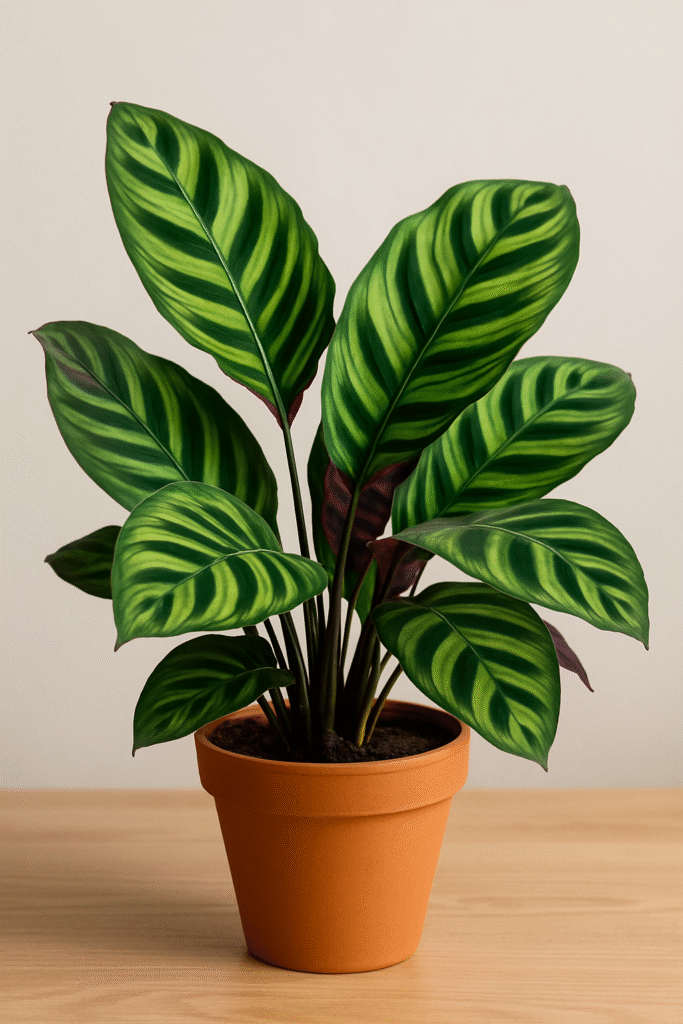Calathea is a popular ornamental plant widely cultivated indoors in Brazil and around the world. Known for its lush foliage, unique leaf patterns, and curious daily movements, Calathea is perfect for those who want an elegant, tropical plant that is relatively easy to care for. In this article, we’ll explore everything about this fascinating plant: its origin, popular varieties, care tips, interesting facts, and the benefits it offers for indoor environments.
Origin and Characteristics of Calathea
Calathea is native to the tropical rainforests of South and Central America, including Brazil. It belongs to the Marantaceae family, the same as the prayer plant (Maranta), and is often referred to as a “prayer plant” because of the way its leaves raise at night, as if in prayer—a natural movement known as nyctinasty.
Its standout feature is the striking leaf patterns, with symmetrical designs and vibrant shades of green, purple, and even pink. Each variety of Calathea has its own distinctive personality, making it one of the most sought-after plants by collectors and interior designers.
Popular Varieties of Calathea
There are dozens of Calathea species and hybrids, but a few have become household favorites:
- Calathea ornata – Known for its dark green leaves with thin pink stripes. Elegant and refined.
- Calathea lancifolia (Rattlesnake plant) – Long, wavy leaves with dark green spots and a purple underside.
- Calathea makoyana – Also called “peacock plant” due to its feather-like leaf patterns.
- Calathea zebrina – Features zebra-like stripes on velvety green leaves.
- Calathea roseopicta – One of the most colorful, with pinkish highlights and purple hues.
How to Care for a Calathea
Though it may look exotic, Calathea is not difficult to care for, as long as a few basic needs are met:
🌤️ Light
Calathea prefers indirect, filtered light. Avoid direct sunlight, which can scorch its delicate leaves. Bright, shaded areas near a window with sheer curtains are ideal.
💧 Watering
Calathea likes consistent moisture, but not soggy soil. Water when the top of the soil feels dry to the touch. Always use well-draining soil and pots with drainage holes. Whenever possible, use filtered or rainwater, as Calathea is sensitive to chlorine and minerals.
💨 Humidity
As a tropical plant, Calathea loves humidity. To keep it healthy, maintain high humidity levels using humidifiers, water trays with pebbles, or by grouping plants together.
🌡️ Temperature
Keep your Calathea in a temperature range between 18°C and 26°C (64°F to 79°F). Avoid cold drafts or sudden temperature changes.
🌱 Soil and Fertilizing
Use a light, airy, and well-drained potting mix, such as a blend of peat moss, coconut coir, and perlite. Fertilize once a month during the growing season (spring and summer) with a diluted balanced fertilizer (e.g., NPK 10-10-10).
Common Problems and Solutions
- Brown leaf tips: Usually caused by low humidity or poor water quality.
- Curling or dry leaves: Often a sign of underwatering or excessive light.
- Yellowing leaves: May indicate overwatering or poor drainage.
Most issues are easily resolved with minor environmental adjustments.
Fun Facts About Calathea
- Calathea’s leaves move—they rise at night and lower again during the day.
- Some species are called “prayer plants” due to this daily movement.
- Non-toxic to pets: Safe for homes with dogs or cats, unlike many other decorative plants.
Why Have a Calathea at Home?
Besides its impressive decorative value, Calathea also:
- Purifies the air, helping remove indoor toxins.
- Increases humidity, which is great for dry environments or air-conditioned spaces.
- Creates a relaxing atmosphere, ideal for bedrooms, reading nooks, or living rooms.
Final Thoughts
Calathea is a plant that combines tropical beauty, graceful movement, and bold personality, making it a favorite for indoor gardening enthusiasts. With the right care, it thrives and dazzles with its vibrant and ever-changing appearance.

Upgrade your gardening game with the KHETI 11-Piece Heavy Duty Stainless Steel Garden Tool Set. From digging to planting, this complete kit has everything you need — perfect for plant lovers and an ideal gift for women and mothers.
Get Yours TodayDiscover the charm of the Clusia — a hardy and versatile plant that adapts beautifully indoors and outdoors. Learn care tips, styling ideas, and why this plant is a favorite among gardeners.
Read the Clusia Guide
